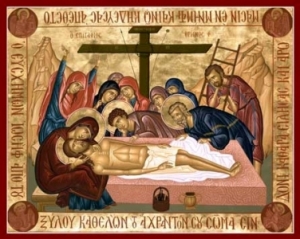
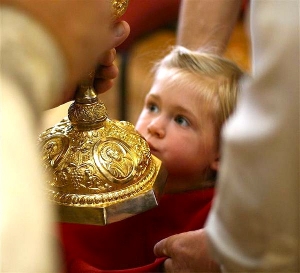
Father George Bithos' weblog

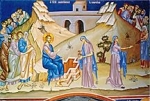
Chapters 7 and 8 of Behr-Sigel’s essays centre on the central theme of Mme. Sigel’s life, the issue of women and men in the Church. As these chapters are read, it must be pointed out that the essays were written for the most part in the 1980’s and 1990’s. The reason I call this to the mind of readers is that at that time this topic was being encouraged by the general trends in ecumenical and theological scenes world-wide. Unfortunately, the extension of this movement, a more significant role for women in the Church, led to a relativism that opened the door for the current and more difficult issue within the contemporary ecumenical setting. The newest difficulty for the Orthodox is the problem of the role of practicing homosexuals, be it their “marriage” or ordination.
The injustice is that this current development has pushed aside the valid concern of the role of women. This issue is a topic that must be faced with thoughtful study and consideration. Behr-Sigel introduces her approach to this topic with a discussion of the question of Holy Tradition vs. common tradition. This inquiry is tantamount to the consideration of the conversation about women and the Church. What is true Tradition and what is custom? Our Church is a Church of Living Tradition; from this Holy Deposit of truth springs all the teachings of the Church. The Bible, the dogmas, the teachings of the Holy Fathers and Mothers of our life as a people of God are all part of Holy Tradition. This Tradition is the sinew of faith. In addition, the life of the Church in history develops traditions with a little “t” which are the practices and customs which acculturate the Church in a time and place. There are times that these two traditions are confused. They are not only confused, but in an attempt to preserve essential Tradition, everything is zealously preserved even the non-essential. What is the true authority by which the Church is regulated? Within these two traditions, the ferment and question of the role of women becomes entangled. Did we not have women deaconesses within the Holy Tradition of our Church? Did we not see their diminished manifestation in the tradition (little t)? The Church of today must grapple with this question. Behr-Sigel asks the difficult questions, while witnessing to the process by which the Church is using to deal with these matters.The theological foundation which forms the backdrop of this conversation is the subject matter of the next few chapters.The beginning point is, of course, the example of Jesus and His relationship with women. The essay points out correctly Our Lord dealt with the person, not with groups. He encountered individual humans, not men or women, not colours or nationalities, nothing but a personal encounter with God was the reality of coming face to face with the Messiah. Behr-Sigel rightly calls to our attention that Jesus shattered the “tradition” of His time concerning with whom he “should” associate. Women, tax collectors, adulterers, prostitutes, Samaritans, lepers, those possessed by demons; none were taboo for the touch of the Master. These examples are telling us what is important is the person relationship with Christ, the encounter not the convention of society. Is this example borne out in the life of Church? What is the Tradition and what is tradition?
]]> Orthodoxy and Peace. Rightly, the beginning of this chapter deals with the liturgical aspect of peace. Even though it is not always emphasized, this should be the crux of any discussion of the theology of the Church. I once read a statement from a well known Orthodox theologian who endured the Communist repression of the Church in the last century. He said that Church was striped of all her riches, schools, and influence; as long as the Liturgy was served, the Church would survive. This was the reality of persecuted Orthodoxy; liturgy is the heart of the Church and fed the soul of the faithful. Behr-Sigel chose to begin her essay with this observation. She points out the central place of peace within the Divine Liturgy. The deacon begins the Great Litany asking that “peace” be the entire bearing of the participants in the liturgy.
[caption id="attachment_313" align="alignleft" width="150" caption="Peace Unto All"]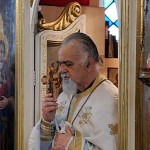 [/caption]
The priest blesses and calls for “peace for the congregants and they respond asking for his spirit to be peaceful. Clergy exchange the Kiss of Peace. With the exception of the personal pronouns “we and us,” peace is the single most often used word in our liturgy. After focusing on the centrality of peace in the liturgy, Elisabeth then discusses the effect that nationalism and national identity influence the Church and its mission to strive for peace among nations. No doubt, complex geopolitical issues affect the closely knit church-state relations in many Orthodox countries. Behr-Sigel points out areas of concern to Orthodox peoples; Serbia (note the date of the article), Palestine, and the cooperation of Constantinople, Russia and the WCC and peace efforts. Never the less, the increased presence of Orthodoxy in the west should help provide a catalyst for a pan-orthodox peace movement. For further information link to the Orthodox Peace Fellowship (http://www.incommunion.org)
Chapter Four discusses a theological theme which is dear to my heart. The topic is the concept of kenosis.(see post Standing by) The scriptural heart of this principle is not only Philippians 2, 5-7 as pointed out in the essay, but also all of salvation history.
[caption id="attachment_319" align="alignright" width="150" caption="Extreme Humility"]
[/caption]
The priest blesses and calls for “peace for the congregants and they respond asking for his spirit to be peaceful. Clergy exchange the Kiss of Peace. With the exception of the personal pronouns “we and us,” peace is the single most often used word in our liturgy. After focusing on the centrality of peace in the liturgy, Elisabeth then discusses the effect that nationalism and national identity influence the Church and its mission to strive for peace among nations. No doubt, complex geopolitical issues affect the closely knit church-state relations in many Orthodox countries. Behr-Sigel points out areas of concern to Orthodox peoples; Serbia (note the date of the article), Palestine, and the cooperation of Constantinople, Russia and the WCC and peace efforts. Never the less, the increased presence of Orthodoxy in the west should help provide a catalyst for a pan-orthodox peace movement. For further information link to the Orthodox Peace Fellowship (http://www.incommunion.org)
Chapter Four discusses a theological theme which is dear to my heart. The topic is the concept of kenosis.(see post Standing by) The scriptural heart of this principle is not only Philippians 2, 5-7 as pointed out in the essay, but also all of salvation history.
[caption id="attachment_319" align="alignright" width="150" caption="Extreme Humility"] [/caption]
The kenosis of Our Lord is at the center of Orthodox theology. God humbling Himself to take on flesh, so that He could identify with us His creation is the essence of His salvific mission in obedience to the will of the Father. The hymns, poetry and art of the Church bear witness to this tenet. Behr-Sigel describes the prevalence of this concept in Russian theological thought and literature. The monastic vocation is a true reflection of this theological concept and has been since its inception in the Egyptian and Palestinian deserts. Modern Greek theologians Zizioulas, Nellas, and Vlachos; in addition to many familiar Russian theologians have written about this aspect of Orthodox theology. Dr. Behr-Sigel masterfully weaves the theme of kenosis and its imprint on the soul of Russia and her people.]]>
[/caption]
The kenosis of Our Lord is at the center of Orthodox theology. God humbling Himself to take on flesh, so that He could identify with us His creation is the essence of His salvific mission in obedience to the will of the Father. The hymns, poetry and art of the Church bear witness to this tenet. Behr-Sigel describes the prevalence of this concept in Russian theological thought and literature. The monastic vocation is a true reflection of this theological concept and has been since its inception in the Egyptian and Palestinian deserts. Modern Greek theologians Zizioulas, Nellas, and Vlachos; in addition to many familiar Russian theologians have written about this aspect of Orthodox theology. Dr. Behr-Sigel masterfully weaves the theme of kenosis and its imprint on the soul of Russia and her people.]]>
AS OUR HOLY ORTHODOX CHURCH PREPARES US GREAT LENT, SHE PREPARES US FOR A JOURNEY. SHE SPEAKS TO US CONCERNING OUR JOURNEY TO PASCHA. THE JOURNEY WE BEGIN IS TO THE CROSS, TO THE TOMB AND TO THE GLORIOUS RESURRECTION OF OUR LORD, GOD AND SAVIOUR, JESUS CHRIST. WE ARE REMINDED THAT WE WILL NOT MAKE THIS JOURNEY ALONE, BUT THAT WE WILL JOURNEY WITH THE LORD, AND TRAVEL WITH OUR BROTHERS AND SISTERS IN CHRIST. PREPARING FOR THIS JOURNEY WE ARE NOT GIVEN A LIST OF THINGS TO BRING, NOR DOES THE CHURCH TELL US WHAT TO EAT OR NOT TO EAT ON THE ROAD. HOWEVER, SHE SPEAKS DIRECTLY TO US ABOUT OUR ATTITUDES. LENT CAN BE SUMMED UP BY THE PHRASE, “SHARING AND CARING” INSTEAD OF “DO’S OR DON’TS”. ATTITUDES CONCERNING OUR NEIGHBOUR ARE OF THE PRIMARY IMPORTANCE DURING THIS PREPARATION FOR PASCHA. IN OUR HEARTS, EACH OF US KNOWS THAT OUR LIVES ARE FAR FROM PERFECT. WE REALIZE THAT WE MUST SEEK FORGIVENESS FROM GOD FOR FALLING AWAY FROM HIM, BY PUTTING HIM OUT OF FOCUS IN OUR LIVES. WE KNOW THAT THIS FORGIVENESS IS NECESSARY FOR OUR RETURN TO HIM. AT THE BEGINNING OF THE GREAT FAST, WE ARE TOLD THAT THE FORGIVENESS, WHICH WE SEEK FROM GOD IS CONDITIONAL. IT IS CONTINGENT ON OUR ATTITUDES TOWARD OTHERS. ARE WE PREPARED TO SHARE OURSELVES WITH OUR NEIGHBOUR? ARE WE PREPARED TO CARE WITH COMPASSION? CAN WE FORGIVE OTHERS? DO WE CARRY ANIMOSITY IN OUR HEARTS, WHILE SEEKING FORGIVENESS FOR OURSELVES? OUR FORGIVENESS FROM GOD IS COMMENSURATE WITH THE FORGIVENESS WE OFFER THOSE WHO HAVE OFFENDED US. THE GREAT CHRISTIAN MARTYR OF THIS LAST CENTURY, DIETRICH BONHOEFFER SUMMED UP OUR RESPONSIBILITY TO OUR FELLOW CHRISTIANS IN THIS WAY:
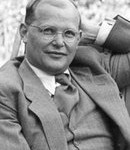
“REJOICING IN THE VIRTUES OF THE SPIRIT – MAY WE PERSEVERE WITH LOVE, AND SO BE COUNTED WORTHY TO SEE THE SOLEMN PASSION OF CHRIST OUR GOD, AND WITH GREAT SPIRITUAL GLADNESS TO BEHOLD HIS HOLY RESURRECTION.”
]]> Today, I’d like to share a miracle which came into our life. God provided us an example of his great love. We shared in the blessing of life. Today, our new grandbaby arrived. He is number five. He joins his three little girl cousins and his big brother, Vassili, but he is the first to grace us while I am doing this blog. It seems only right to share some reflections on him joining our family. The truth is ever since we learned that Katina, our daughter, and Vastan, our son-in-law were expecting, we have been praying for them and the new baby.
[caption id="attachment_244" align="alignright" width="105" caption="Peter"] [/caption]
When we learned the baby was going to be a boy he acquired a name, Peter Nicholas. The little guy was going to be named for his two uncles, one on each side of the family. Little Peter has been a topic of great speculation. When exactly would he come, how much he would weigh, how big would he be? Well, today we got all our questions answered. He made his appearance on February 21, 2009, he is 191/2” long and he weighs 7.4lbs.
[/caption]
When we learned the baby was going to be a boy he acquired a name, Peter Nicholas. The little guy was going to be named for his two uncles, one on each side of the family. Little Peter has been a topic of great speculation. When exactly would he come, how much he would weigh, how big would he be? Well, today we got all our questions answered. He made his appearance on February 21, 2009, he is 191/2” long and he weighs 7.4lbs.
I once heard that a baby was proof positive that God is love. This is one of the most simple and most profound statements we could consider. St. John the Evangelist states so plainly, “God is love” (1John 4, 8). Our God is a community of love, a constant exchange of love between the three persons of the Holy Trinity. A new life is a reflection of that love. Here on the desk is an icon of the Glukofilousa, (The Sweet Kissing Virgin). What a beautiful expression of love between the Theotokos and Christ, what peace, what perfect joy. Here into our life, that joy is revealed once more. 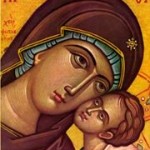 We need to be open to God’s love, to allow it to permeate our soul and to have appreciation for it when it comes. This can happen not only in the big events, like the birth of a new baby; but in the little things. That is the challenge, stopping to recognize God revealing Himself and His love to us and letting that blessing soften our heart and bring joy into our life. Look at your life. Has God revealed Himself and His love to you? Maybe He has, but you were too busy or preoccupied to notice. The pace of life is so fast that many times we can not recognize the love of God. It may be that small event, that person we meet or the opportunity to open our own heart; yet we do not cherish the moment or perceive the encounter with the love of God. St Silouan the Athonite prayed, “O Lord, by Your Holy Spirit enlighten Your people that all may know Your love.”
We need to be open to God’s love, to allow it to permeate our soul and to have appreciation for it when it comes. This can happen not only in the big events, like the birth of a new baby; but in the little things. That is the challenge, stopping to recognize God revealing Himself and His love to us and letting that blessing soften our heart and bring joy into our life. Look at your life. Has God revealed Himself and His love to you? Maybe He has, but you were too busy or preoccupied to notice. The pace of life is so fast that many times we can not recognize the love of God. It may be that small event, that person we meet or the opportunity to open our own heart; yet we do not cherish the moment or perceive the encounter with the love of God. St Silouan the Athonite prayed, “O Lord, by Your Holy Spirit enlighten Your people that all may know Your love.”